Difference between revisions of "Hull"
| Line 67: | Line 67: | ||
| [[Cluster Hull]] | | [[Cluster Hull]] | ||
| [[Spacecraft]] / [[Vacuum]] | | [[Spacecraft]] / [[Vacuum]] | ||
| − | | [[ | + | | [[Cluster Hull]] |
| − | * [[ | + | * [[Close Structure Hull]] |
* [[Dispersed Structure Hull]] | * [[Dispersed Structure Hull]] | ||
* [[Distributed Structure Hull]] | * [[Distributed Structure Hull]] | ||
Revision as of 02:44, 21 August 2019
The Hull is the main body of a ship, boat, or other vessel type. [1]
- It contains the superstructure, frame, skeleton, and internal structure among other terms.
- It is often called a fuselage, airframe, or chassis on smallcraft or vehicles.
- Hulls have two primary characteristics (specifications) of hull shape and streamling as well as several other minor ones.
- Some hulls are built as Tail-sitters.
- It is the major location of Ship Equipment.
- Hulls are commonly divided into two major sections, the Main Compartment and Engineering Compartment.
Library Data Referral Tree
Please see the following AAB Library Data articles for more information:
Ship Design:
- Naval Construction
- CBPUSAL (Hull)
- Imperial Ship Builders Association (ISBA)
- Naval Architect AKA Shipwright
- Quick Ship Design System (QSDS)
- Quick Ship Profile (QSP)
- Ship Equipment
- Ship Registry
- Ship's Papers
- Shipyard
- Standard Ship Design System (SSDS)
- Starport Authority (SPA)
- Trader's Guild
- Travellers' Naval Architecture Society (TNAS)
- Universal Ship Profile (USP)
Description (Specifications)
Hulls or fuselages are the skeletons, internal structures, and other core structural features of a craft capable of atmospheric flight, spaceflight, or starflight. [1]
Hulls are identified by their mass displacement, expressed in tons of displaced liquid hydrogen. When hulls are constructed, they are divided into an engineering section for the drives and the main compartment for everything else. Standard hulls are available at reduced prices and construction times. Any other hull must be produced on a custom basis. Hulls vary in their requirements for drives and power plants based on tonnage. [1]
The CBPUSAL-7 Hull Series are considered the seven basic known hull types. All other hull variations are considered subtype variations. Certain streamlining configurations are associated with each of the seven hull types, but variations are possible among un-streamlined, partially streamlined, and fully streamlined orientations among other possibilities.
Hull Explication
The Hull: Hulls are identified by their mass displacement, expressed in tons. As a rough guide, one ton equals fourteen cubic meters (the volume of one ton of liquid hydrogen and its tank structure). When hulls are constructed, they are divided into an engineering section for the drives and the main compartment for everything else. All drives and power plants must be located in the engineering section, and only drives and power plants may be placed in that section. All other ship components, including fuel, cargo hold, living space, and computer must be located in the main compartment. [2]
There are seven standard hulls which are available at reduced prices and construction times. Any other hull must be produced on a custom basis at a cost of MCr0.1 per ton with a minimum price MCr20. Construction (or build) times for custom hulls can often be much longer than standard hull construction. Hulls vary in their requirements for drives and power plants based on tonnage. [2]
Any specific drive will be less efficient as the tonnage it must drive increases. There are twenty-four standard drive types, identified by the letters A through Z (omitting I and O to avoid confusion). Also listed are various tonnage levels for hulls; any tonnage which exceeds a listed level should be read at the next higher level. Correlating hull size with drive letter indicates drive potential. For maneuver drives, this potential is the G’s of acceleration available. For jump drives, the potential is the jump number (Jn), or jump range in parsecs. For power plants, it is power plant rating (Pn). For example, a 200-ton hull equipped with maneuver drive-A can produce 1-G acceleration; an 800-ton hull equipped with jump drive-K can produce jump-2. [2]
A ship’s hull is broadly composed of two sections:
- Engineering Compartment / Section
- Main Compartment / Section
Image Repository
| CBPUSAL Function Designation | ||||||
|---|---|---|---|---|---|---|
| C | B | P | U | S | A | L |
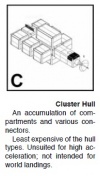
|

|
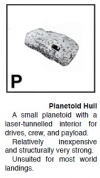
|
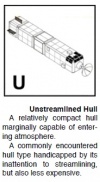
|
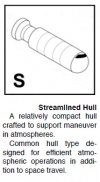
|
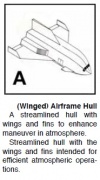
|
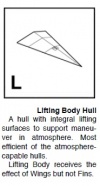
|
| CBPUSAL Function Designation | |||||
|---|---|---|---|---|---|
| Image | Code | Hull | Primary Environment | Subtypes | Remarks (Synopsis) |

|
C | Cluster Hull | Spacecraft / Vacuum | Cluster Hull | Simple spacecraft hull suited to cargo transport.
|

|
B | Braced Cluster Hull | Spacecraft / Vacuum | Braced Hull | Intermediate complexity spacecraft hull suited to cargo transport at increased acceleration rates.
|

|
P | Planetoid Hull | Spacecraft / Vacuum | Planetoid Hull | Simple complexity hull with advantages in durability and readily available. |
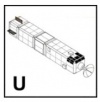
|
U | Unstreamlined Hull | Spacecraft / Vacuum | Box Hull | Simplest spacecraft hull. Very basic, simple, and enduring. |
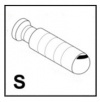
|
S | Streamlined Hull | Interface Craft / Atmosphere | Cone Hull | Complex hull. Minimizes atmospheric drag. Also available as a Partially Streamlined Hull. |
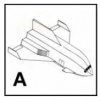
|
A | Airframe Hull | Interface Craft / Atmosphere | Wedge Hull | Intermediate complexity hull. Increased atmospheric maneuverability. Also available as a Partially Streamlined Hull. |
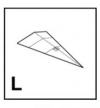
|
L | Lifting Body Hull | Interface Craft / Atmosphere | Flattened Sphere Hull | Very complex hull. Best lift capabilities. Also available as a Partially Streamlined Hull. |
NOTES: Hulls are not limited in application. It is possible to build hulls across a variety of applications and characteristics. Hull terminology is often duplicative with semantic overlap.
Physical Structure (Surface)
Secondary Hull Characteristic:
- Access points
- Airlocks
- Cargo Ramps
- Bay
- Bulkhead Walls
- Docking point
- Equipment Attachment points
- Drop Tank mount
- Hardpoints (Weapon mount)
- Internal compartments
- Landing Gear
- Fixed Landing Gear
- Recessible Landing Gear
- Stealth Hull
- Tonnage (Tons of displacement, equivalent to 1 Ton of liquid hydrogen).
Configuration (Shape)
Primary Hull Characteristic:
- Box Hull
- Braced Hull
- Close Structure Hull
- Braced Cluster Hull (consisting of linked subhulls and pods, able to withstand acceleration and gravity wells)
- Cluster Hull (consisting of linked subhulls and pods)
- Cone Hull
- Cylinder Hull
- Dispersed Structure Hull / Irregular Structure Hull
- Flattened Sphere Hull
- Needle Hull
- Open Frame Hull
- Planetoid Hull
- Sphere Hull
- Wedge Hull
Streamlining (Aerodynamics)
Primary Hull Characteristic: Streamlining may be inherent to the configuration, or it may be an applied design feature:
- Airframe Hull
- Wings and Fins
- Lifting Body Hull
- Partially Streamlined Hull
- Streamlined Hull
- Unstreamlined Hull
Fuels Scoops
A hull may be additionally equipped for wilderness refuelling with:
- Fuel Scoops
- These are sometimes referred to as Onboard Fuel Scoops
Aircraft hulls may be equipped with intakes for various engine types for atmospheric flight.
Hull Materials / Hull Armor (Defensive Frame)
Secondary Hull Characteristic:
| Primary structural material: Hull Armor & Materials | ||
|---|---|---|
| Type | TL | Remarks |
| Iron | TL-3 | Iron is a common and relatively hard metal armor used by many TL:1-3 and some later vehicles. |
| Steel | TL-4 | Steel armor is the next step of hardened metal armor used by TL:4-6 vehicles. |
| Hard Steel | TL-5 | Hardened steels are a marked improvement over previous armors and give military and engineering advantages. |
| Light Alloys | TL-6 | None |
| Titanium Alloy | TL-6 | None |
| Composite Laminate | TL-7 | None |
| Lightweight Composite Laminate | TL-9 | None |
| Crystaliron | TL-10 | None |
| Superdense | TL-12 | None |
| Bonded Superdense | TL-14 | None |
| Coherent Superdense | TL-17 | None |
| Organic Armor | Various | Organic armor is difficult to categorize by TL and comes in a vast variety of forms and effective levels of sophistication. |
| Future Armor | TL:19-21+ | No one knows what may come, but futurologists are guessing... |
- Compartmentalization
- Electrostatic armor
- Hull plating
- Inherent armor (Planetoid Hulls)
- Reactive armor
- Reflec coating
- Structural bracing
Additional Features (Accoutrements)
Secondary Hull Characteristic:
- Exterior Windows
- Heat Shielding
- Non-electronic masking methods
- Radiation Shielding
- Stealth coatings
- Surface finish (color scheme), markings, and logos
History & Background (Dossier)
Hulls are a vital part of any large, complex technological transportation conveyance. they range from the earliest found materials to massively processed materials such as smelted metals, alloys, polymers, composites, ceramics, nano-materials, and more. And despite the many different materials, the basic engineering principles and vehicles and vessel construction have changed very little over thousands of years. [1]
Technological Overview of Hull Development
Unpowered aircraft using floaters or harnessed flying creatures typically become available to sophonts in the TL:1-3 epoch.
- By the TL:4-6 tech epoch, powered aircraft become first possible to the average sophont civilization. Some even use rockets or other technology to reach space.
- By the TL:7-9 tech epoch, regular spaceflight becomes possible.
- By the TL:10-12 tech epoch, routine starflight using FTL jump drives becomes routine.
At higher technological epochs, more advanced forms of starflight become theoretically possible including trans-universal or trans-brane transportation to multiverses. Some believe that chronotaxis or time travel may become routinely available in the far future.
Expected Tech Epoch Transitions
Airflight:
Transatmospheric Flight:
CBPUSAL Function Designation Streamlining Spectrum
The Imperial Ship Builders Association (ISBA) qualifies modern naval hulls across this spectrum:
- C. Cluster. An accumulation of compartments.
- B. Braced Cluster. Structured for higher acceleration.
- P. Planetoid. A hollowed nickel-iron asteroid.
- U. Unstreamlined. Protrusions increase drag.
- S. Streamlined. Cowlings and fairings decrease drag.
- A. Airframe. Winged for performance in atmosphere.
- L. Lifting Body. Radically streamlined lifting-surfaces.
References & Contributors (Sources)
| This article has metadata. |
- Marc Miller. Starships (Game Designers Workshop, 1977), 13. (Classic Traveller, Book 2)
- Marc Miller, Frank Chadwick, John Harshman. High Guard (Game Designers Workshop, 1980), TBD. (Game Designers Workshop 1980) (Classic Traveller, Book 5)
- Marc Miller. Referee's Manual (Game Designers Workshop, 1987), TBD.
- Frank Chadwick, Dave Nilsen. Fire, Fusion, & Steel (Game Designers Workshop, 1994), TBD.
- Marc Miller. T5 Core Rules (Far Future Enterprises, 2013), TBD.
- EXTERNAL LINK: Ship Structure and Hull Size Limitations at Freelance Traveller by Christopher Thrash
- Traveller Wiki Editorial Team
- Author & Contributor: Lord (Marquis) and Master Scout Emeritus Adie Alegoric Stewart of the IISS
- Author & Contributor: Lord (Marquis) and Master of Sophontology Maksim-Smelchak of the Ministry of Science
- ↑ 1.0 1.1 1.2 1.3 Information provided to the library by Maksim-Smelchak
- ↑ 2.0 2.1 2.2 Marc Miller. Starships (Game Designers Workshop, 1977), 13.
